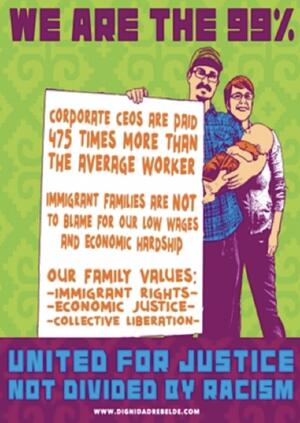Occupy the Hood — We are the 99% | As the Occupy Wall Street (OWS) movement mushroomed city by city in states across the country, the need to make room to expand a vision of racial equity through the participation and leadership of communities of color came to the fore. In early October, OWS participant New Yorker Malik Rahsaan launched Occupy the Hood in order to involve more people of color in the OWS movement. Later joined by Ife Johari Uhuru of Detroit to coordinate outreach, Occupy the Hood leveraged social media tools like Facebook and Twitter to amass more than 7,000 followers in its early inception. Comprised of individuals and organizations, their mission states “From Occupation to Liberation, De-Colonize, Empower The Hood”, “People of Color, and in particular Black, Brown and Native/Indigenous People, have been disproportionately affected by the issues that the Occupy Movement has recently raised. Unemployment rates double nationwide, disproportionate incarceration rates, wealth gap, subprime mortgages/foreclosures.”


Moving from a frame of solely diversifying the Occupy movement is a central task. In The Nation, Rinku Sen, Executive Director of the Applied Research Center and Publisher of Colorlines.com argues that the movement must “occupy racial equity”: “How can a racial analysis, and its consequent agenda, be woven into the fabric of the movement? We need to interrogate not just the symptoms of inequality, but, more fundamentally, the systems of inequality, considering how and why corporations create and exploit hierarchies of race, gender and national status to enrich themselves and consolidate their power.”
-
The Colorful Mamas of the 99% – parents and children organize protests on local banks
-
January 20, 2012 (J20): profiling the investment of detention centers and private prisons by financial institutions that also played key roles in the foreclosure crisis
-
Bronx students Occupy Public Education:
The Arts Research Center at UC Berkeley is sponsoring the working session “Occupy as Form” on February 10, 2012. Participants have been invited to post some brief thoughts on the topic in advance of the event. This guest posting is by Gina Acebo, a first-year MFA candidate focusing on Social Practice at California College of the Arts.
